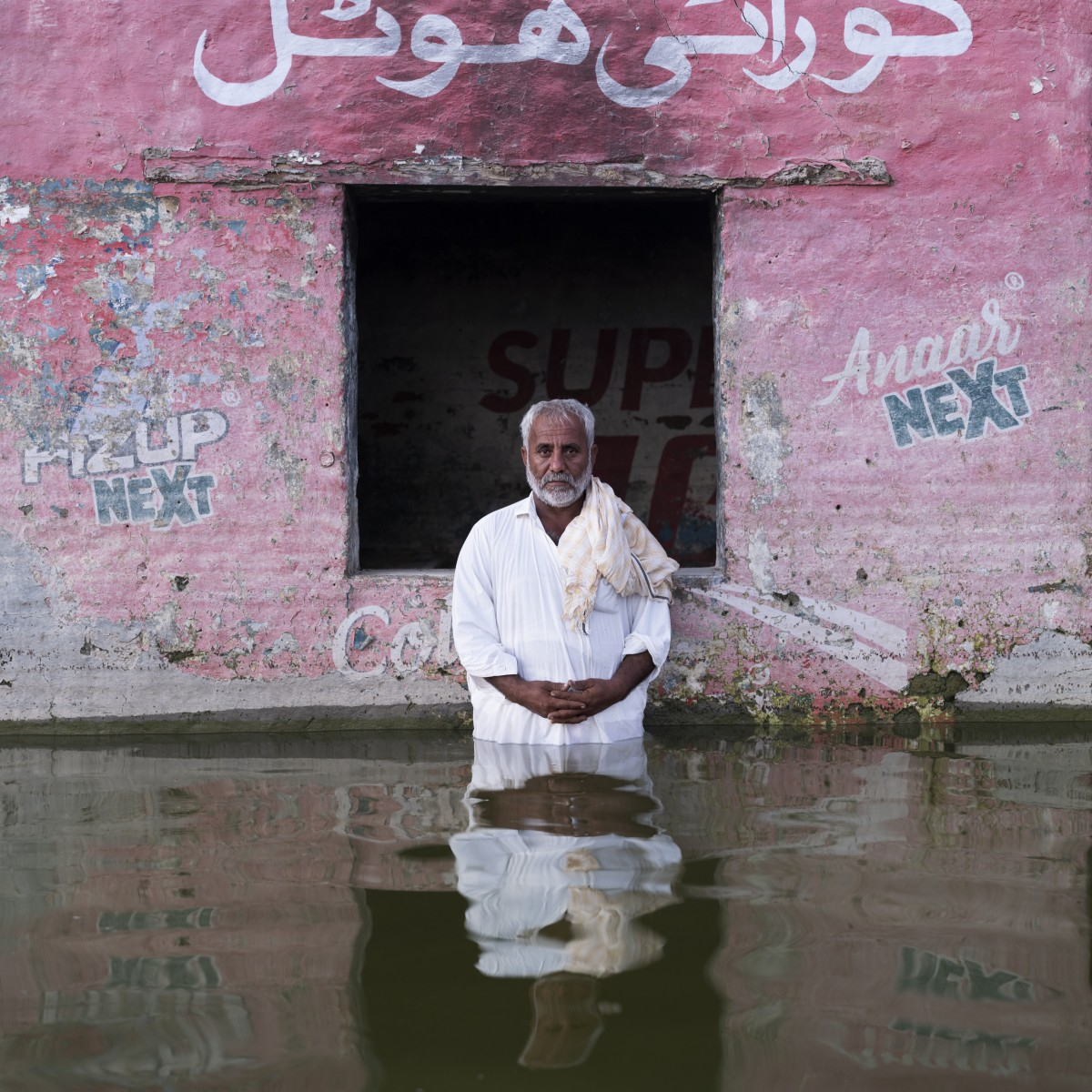Share post now
Article
The miraculous increase in Swiss climate finance
06.12.2022, Climate justice
On paper, Switzerland has more than tripled its support to developing and emerging countries for climate protection in the last ten years. – Is that true? A look at the "accounting" of the Swiss Confederation.

Muhammad Chuttal Korai outside his family's restaurant in Khairpur Nathan Shah, Pakistan. More than 1,500 people lost their lives and millions their homes in the 2022 flood.
© Gideon Mendel / Drowning World
The disastrous flooding in Pakistan is just one example. With each passing year, the impacts of global warming are becoming more intense and more obvious. Often, it is the poorest countries and the most vulnerable population groups that are the worst affected. They are the ones most in need of adapting to changing climate, whether by protecting their coastlines from storms and floods or adapting their agricultural practices to heat and drought. At the same time, climate neutrality is a must in all countries if global warming is to be limited to 1.5 degrees centigrade. No matter how you look at it, climate change remains a global challenge.
Not only is the Global North responsible for the climate crisis, but it also possesses the most financial resources, both for mitigating and adapting to climate change. As early as 2010, the international community decided that industrialized countries had to make available USD 100 billion per annum to developing and emerging countries as of 2020 to enable them to finance the development of their net zero societies and the required climate change adaptation. The Framework Climate Convention stipulates that this should represent new and additional funds. But political will alone was not enough to ensure that the cost is shared in a binding manner among the countries responsible. It is hardly surprising, therefore, that the global target was missed in the year 2020. According to the Organization for Economic Cooperation and Development (OECD) – optimistically calculated with the official figures from donor countries –- an amount of USD 83.3 billion was reached; 71 per cent of those funds nevertheless consisted of loans, and must be repaid. This raised the debt levels of the receiving countries even further.
Based on a combination of the polluter pays principle and our level of welfare, the Swiss government calculates that Switzerland should contribute between USD 450 million and USD 600 million towards the global funding target. That is too low; the fair share would be 1 billion[1] – taking into account Switzerland's emissions that are generated abroad. The government also states the principal source of the funds, namely, the existing budget for international cooperation, which has not been increased beyond the level of the general federal budget over the years. At the same time, those funds are also intended to ensure compliance with international guidelines on official development assistance (an area in which Switzerland still falls very short). The guiding principle is: report twice, pay once.
In this connection, Switzerland is now placing ever greater emphasis on the climate factor in development cooperation, and is attributing a growing number of projects to climate funding. This explains the doubling of Switzerland's contribution towards bilateral climate projects between 2011 and 2020. The Swiss Agency for Development and Cooperation (SDC) as well as the State Secretariat for Economic Affairs (SECO), both of which bear responsibility for these projects, are of course right to give a more prominent place to climate change in their projects. It is not clear, however, whether all projects were intentionally conceived as climate-relevant, or whether projects are being retrospectively classified as such. They are certainly being counted twice alongside development cooperation.
A second reason for the sharp increase in reported climate funding stems from Switzerland's contributions to multilateral institutions. These include multilateral funds such as the Green Climate Fund (GCF) and institutions that address a broader range of topics, such as development banks. Climate funds were established specifically to implement the Climate Convention. Switzerland's contribution to them is increasing, and rightly so, but in 2020 represented only a third of the country's multilateral climate funding. Two-thirds are being invested through development banks - the World Bank first and foremost. There too, the situation is similar to that of bilateral development cooperation, in that more and more projects previously existing in the portfolio are being imputed to climate funding. With new imputation methods for multilateral contributions, Switzerland's climate funding has repeatedly increased in leaps and bounds over the years.
For the year 2020, for example, Switzerland reported to the United Nations an amount of USD 411 million in climate finance, including USD 106 million in private funds that were "mobilized" thanks to public funds (e .g., through start-up financing or guarantees for high-risk private investments). The Federal Council seems quite satisfied with this. However, new and additional funds for climate financing that were not "pinched" from the development budget represent a tiny fraction. This comprises modest contributions to multilateral climate funds – amounting to USD 68 million. The Confederation's books are sometimes worth a read.
[1] The Swiss government includes Switzerland's domestic emissions only – although the environment report of the Federal Office for Environment (FOEN) shows that 57 per cent of Switzerland's climate footprint consists of emissions generated abroad as a result of our consumption. Based on the overall footprint, Switzerland's fair share would be 1 billion dollars or 1 per cent of the global funding target.
Climate financing in brief
In international climate policy, climate funding means climate-related financial support for developing and emerging countries. The poorest countries are the ones least responsible for the climate crisis and also the least endowed financially for mitigating and adapting to climate change. Climate funding is, however, just one aspect of climate justice. No less important for the Global South is the reduction of CO2 emissions in the North, including Switzerland.
